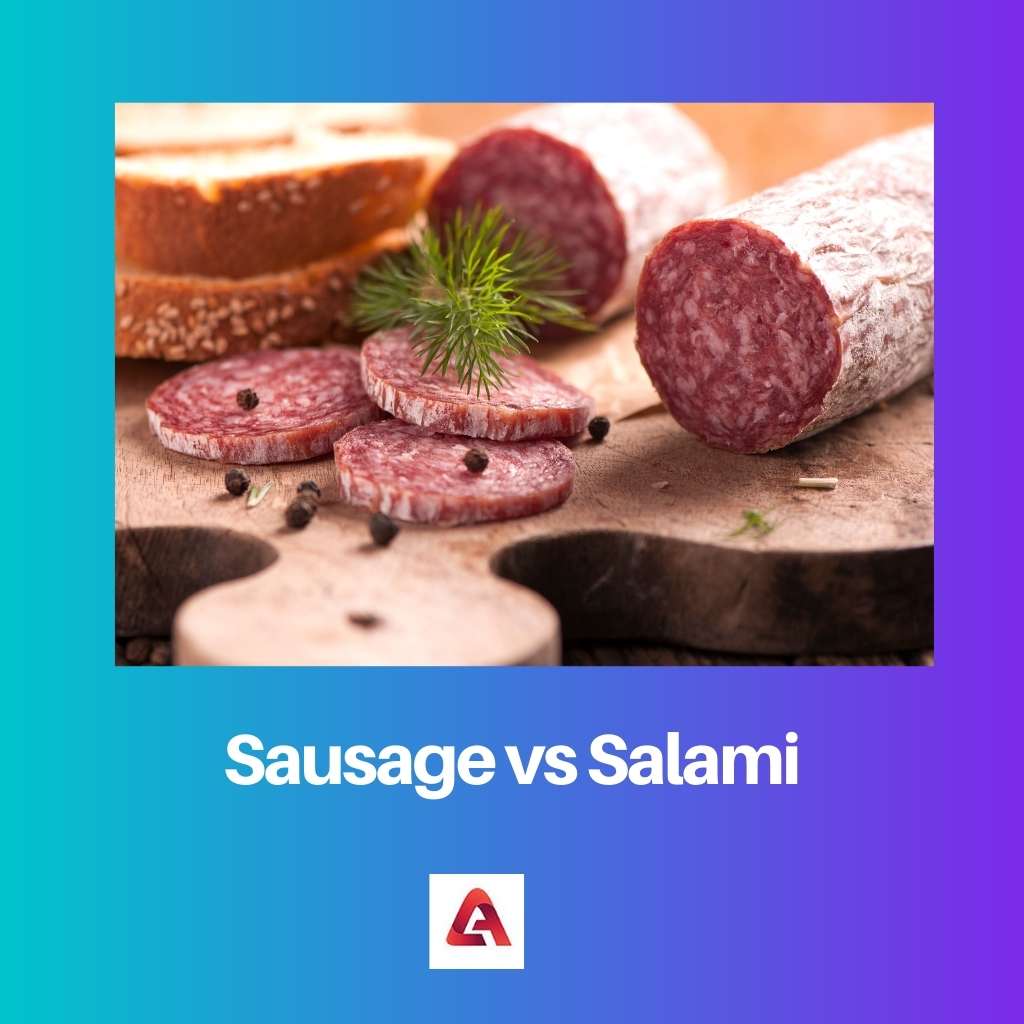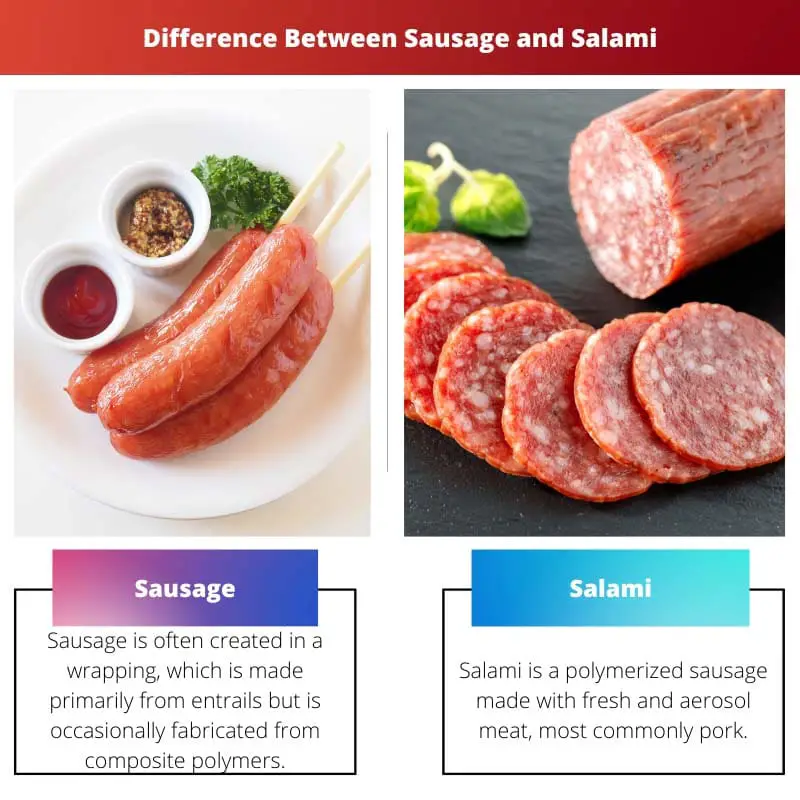Salami is frequently confused with sausage, but this is not the case. This is because these two forms of meat have nearly identical properties.
Therefore, it is necessary to understand the distinctions between salami and sausage. This is because it might assist you in determining the roasting process to utilize for salami or sausage.
Key Takeaways
- Sausage is a ground meat product that can be fresh, cooked, or smoked, while salami is a cured, fermented, and air-dried sausage.
- Salami has a longer shelf life and is eaten uncooked, whereas sausages require cooking before consumption.
- Sausages come in various flavors and meat combinations, while salami contains a mixture of beef and pork with a distinct spiced flavor.
Sausage vs Salami
Sausage is a ground meat mixture stuffed into a casing, while salami is a type of cured sausage fermented and dried. Sausages are cooked before consumption, while salami is eaten raw. Salami has a distinct flavour and texture, whereas sausages have a wide range of flavours.

A sausage is a ground beef patty made from ground meat. The meat might be beef, pig, or chicken, and it is combined with various spices to enhance the tastes. Sausages are provided uncooked and should be prepared before eating.
After being purchased, sausages last 1 to 2 days in the refrigerator. They can, meanwhile, be kept in the refrigerator for up to two months. It is critical to preserve sausages at all times.
Salami is a smoked sausage made from marinated and air-dried pork. The origins of salami may be traced back to Italy. Since there existed no freezers at the moment, people were seeking for techniques to preserve meat for an extended length of time.
Salami is commonly cooked cold, but it can also be ignited. It has the prospect to keep for up to 6 months if not stored in the fridge. Moreover, once salami has been trimmed, it should be refrigerated.
Comparison Table
| Parameters of Comparison | Sausage | Salami |
|---|---|---|
| Sodium | The sodium amount in sausage is 731 mg. | The sodium amount in salami is 1740 mg. |
| Vitamin B5 | The vitamin B5 amount in sausage is 0.51 mg. | The vitamin B5 amount in salami is 1.201 mg. |
| Zinc | The zinc amount in sausage is 1.79 mg. | The zinc amount in salami is 2.93 mg. |
| Phosphorus | The phosphorus amount in sausage is 142 mg. | The phosphorus amount in salami is 191 mg. |
| Saturated Fat | The saturated fat amount in sausage is 11.27 g. | The saturated fat amount in salami is 9.316 g. |
What is Sausage?
Sausage is created in a wrapping, which is made primarily from entrails but is occasionally fabricated from composite polymers. Raw sausages are prepared in a variety of methods, involving pan-frying, overcooking, and grilling.
Some sausages are roasted while the manufacturing operation, and the shell is subsequently retracted. Making sausage is a classical method of food preservation.
Some hardened or barbecued sausages can be kept at room temperature. The majority of raw sausages must be chilled or stored once cooked.
A sausage is a sort of piece of beef that is manufactured using corned beef, most frequently pig, beef, or chicken, as well as salt, seasoning, and other flavorings. As spacers or enhancers, other components like cereals or croutons may be used.
The term sausage can correspond to tangled sausage meat that is constituted into dough balls or crammed into a skin. When a commodity is referred to as “a sausage,” it is spherical and enclosed in leather.
Sausage production is a natural outgrowth of effective butchery. To assist maintain diverse cells and tissues, such as leftovers, protein sources, blood, and grease, sausage producers customarily seasoned them.
They then put them into fibrous capsules formed from the organism’s cleansed intestines, giving them their distinctive cylindrical form.
As a result, sausages, desserts, and bologna are among the ancient prepared dishes, perhaps grilled and consumed right away or preserved to differing degrees.

What is Salami?
Salami is a polymerized sausage made with fresh and aerosol meat, most commonly pork.
Salami was widely renowned among peasants in Southern, Southeast, and Continental Europe since it can be preserved at periods of up to 40 days initially prepared, augmenting a potentially poor or unreliable selection of raw meat.
Authentic salami variants are made in several countries and areas throughout Europe.
For a more contemporary governed carbonation, the salami is hung in warm, damp environments for 1–3 days to motivate the Lacto bacteria to survive before being hung in a cool, moist environment to steadily hydrate.
Beef is commonly used in ritual slaughter salami, which does not contain pork for ideological considerations. Other meats, such as rabbit and fowl, are also used by the manufacturers.
In portions of Northern Italy, geese salami is a common dish. Horse flesh was used to make salami. Mule meat is also used for prosciutto in the Normandy area of France, where it is marketed at corner stores.
This combination is then placed into the appropriate size chambers. To obtain the flavor and consistency of salami, expiration, also known as a gradual neutralization method that promotes a chemical reaction that occurs in the flesh, must start happening.
Straight carbonation of meat was shown to be ineffective for salami manufacturing because it produces protein aggregation and inconsistent thrombosis, resulting in an unpleasant salami appearance.

Main Differences Between Sausage and Salami
- Sausage is produced from hamburger meat and has a coating that keeps it from coming pieces. Salami, on the other hand, is a marinated and air-dried healed bacon.
- Sausage may be obtained from a variety of meats. It is not confined to meat and bacon. Salami, on the other hand, can only be constructed between either beef or porcine.
- The flavor of sausage is determined by the components used to produce it. Salami, on the other hand, has a more intense flavor attributable to the substances used to manufacture it.
- Sausage does not go through the curing procedure; it retains its natural sensory properties. Whereas the consistency of salami is tougher because salami absorbs wetness throughout the curing process.
- Sausage is merely chopped raw meat that has to be prepared before it could be eaten. Salami, on the other hand, maybe eaten cold. Salami is created from brewed and air-dried beef.

- https://www.ncbi.nlm.nih.gov/pmc/articles/pmc6784594/
- https://www.sciencedirect.com/science/article/pii/S0309174013002544
